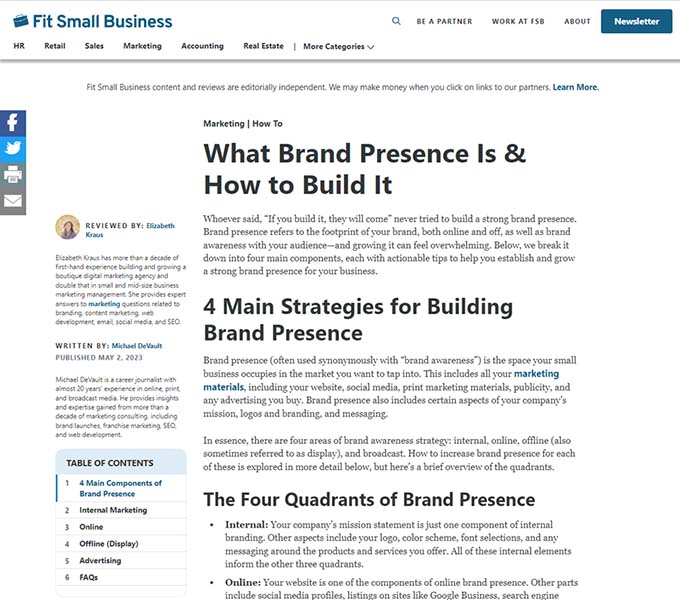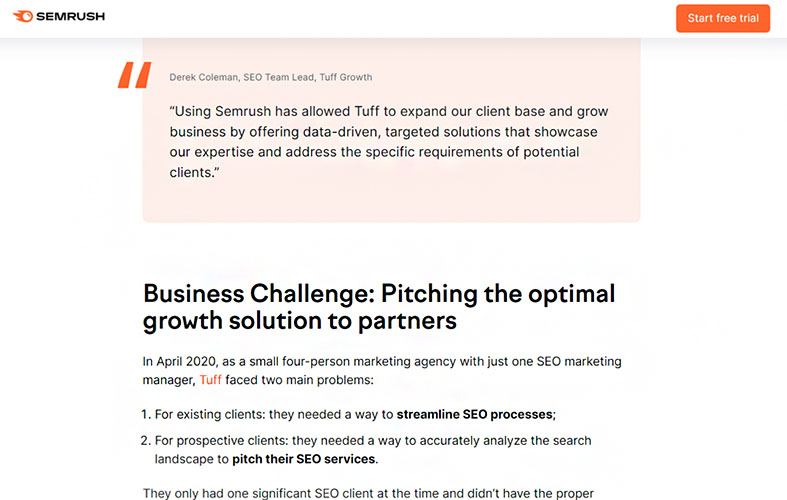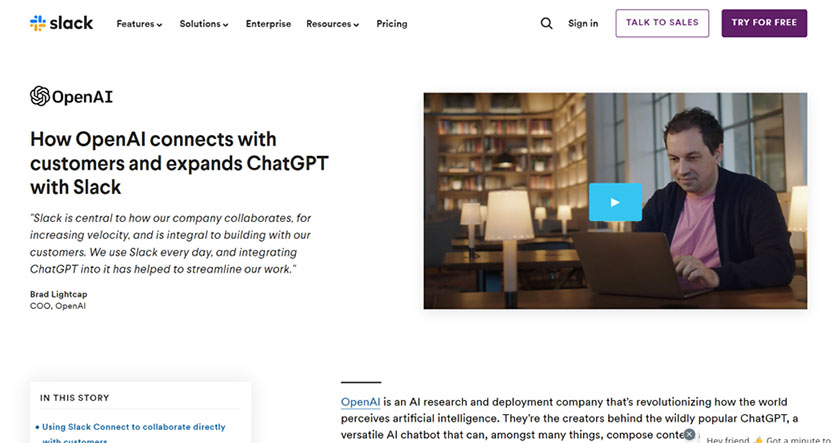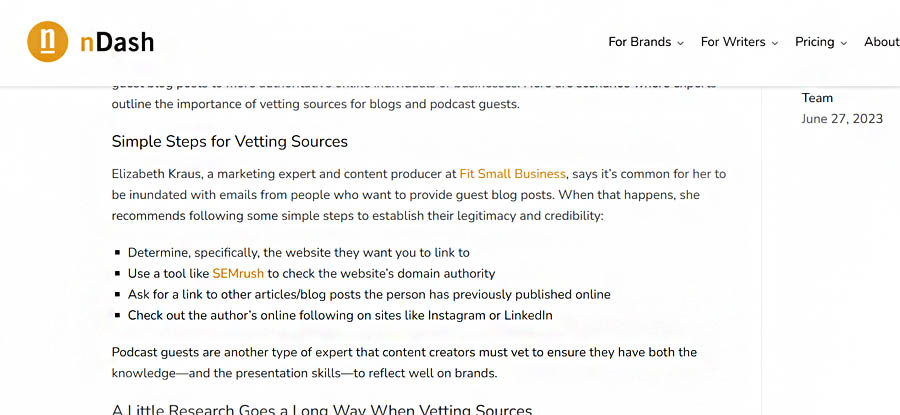One of the best search engine optimization (SEO) strategies to rank higher on Google is to get backlinks from high-authority sites. This leads to higher domain authority for your site, improved rankings, and more web traffic—which ultimately boosts brand awareness and sales. To get backlinks, you first need a website and high-quality content, but there are additional tactics you can use to earn backlinks for SEO, which we cover in the strategies below.
1. Build a High-quality Website
| PROS | CONS |
|---|---|
| Having a good website instills confidence in others that your content is worth linking to | No guarantee you’ll get backlinks from high-authority sites |
| Creates instant trust in your brand as a legitimate business | Requires ongoing maintenance and time investment to create and publish link-worthy content |
Captain Obvious here, but you can’t even start to learn how to get backlinks from high authority sites to build brand presence online until you have a quality website to link back to. Lackluster design, outdated content with broken links, and inaccurate or incomplete information doesn’t look professional and may turn people away from your brand.
For more guidance, check out our step-by-step guide to learn how to make a small business website. Make sure every page on your site has unique target keywords, titles, and meta descriptions, and add image alt tags, social media links, and secure sockets layer (SSL) encryption. If you already have a website, leverage SEO audit tools like Semrush to have your website perform at its best.
You don’t have to invest a ton of time or money to get a great-looking website with all-in-one site builders. We highly recommend Wix. It’s one of the best website builders for SEO, thanks to its advanced tools, artificial intelligence (AI) content writing assistant, and built-in SEO guides.
2. Publish Backlink-worthy Content on a Blog
| PROS | CONS |
|---|---|
| Evergreen content can produce backlinks frequently, forever | No guarantee of high-authority backlinks |
| Gives high-authority sites reasons to link to your site | Backlinks may be “nofollow,” providing minimal SEO benefit beyond traffic the link generates for your website |
| Establishes your brand as an authority | |
| Generates organic web traffic | |
One of the best ways to get backlinks from high-authority sites (as well as web traffic among your target audience) is to add blog content to your site. Topic bloggers and brand websites that use SEO content marketing to drive traffic always need fresh content, so when you have something relevant for them to write about, they’ll be happy to link to it.

An example of evergreen blog content that can attract backlinks
Start with keyword research to ensure you’re using keywords in your online content that target the type of site visitors you want to attract. Then write content that makes sense for your brand, website, and audience. You can then create and send pitches asking for an SEO backlink (i.e., not a “nofollow” link) via email to other websites that might have an interest in your content.
There are many content marketing and local SEO tools to help you find and manage keywords, SEO tactics, and other website optimization methods. For example, try Semrush’s free keyword research tool to target location-specific keywords, and upgrade to get full access to competitor insights and content ideas.
3. Create Listings in Online Directories
| PROS | CONS |
|---|---|
| Builds domain authority and site traffic | Takes time to add and monitor listings, and to see results |
| More ways customers can find your site online—increases your website's visibility | Lots of competition, depending on industry or directory |
| Hundreds of general and industry-specific directories | |
Submitting your website to online directories is an effective way to get your site noticed by search engines and potential customers. When you submit your site to a directory, you are essentially telling the directory’s editors that your site exists and is relevant to their audience. Learn which are the best online business directories to list your company in.
Listings help your site get more traffic and visibility in the search engine results pages (SERPs). Many of these directories have high authority with Google, so the backlinks earned also help your SEO, in turn improving your website’s search engine ranking. However, it’s just one of many easy website marketing strategies you can use to get more website traffic.
4. Publish Customer Success Stories & Case Studies
| PROS | CONS |
|---|---|
| Acts as a positive review or testimonial and de facto endorsement | Identifying which stories to write and writing them takes time |
| Good chance customers featured will share your content with a link via social media, email, or on their website | Featured customers may not have websites (may not be a direct backlink opportunity) |
| Builds trust with prospects | |
Many businesses feature customer success stories in blog posts and portfolios to inspire trust in a product, service, or brand. It’s a common practice for both business-to-business (B2B) and business-to-consumer (B2C) companies to request testimonials to include when writing a case study about a client.

An example of a customer success story with a backlink (Source: Semrush)
Featured customers may write something about your business on their website, giving you a quality backlink to help your site’s authority with Google. Aside from the possibility of getting backlinks from high authority sites, customer success stories help other prospects see the practical value of your offering and brand.
5. Publish an E-book
| PROS | CONS |
|---|---|
| Highly valuable content for prospecting and lead nurturing | Research and writing process usually takes longer than writing blog articles |
| Potential to gain many backlinks | |
| Long shelf life | |
E-books can be produced for any stage of the sales pipeline, but are often used to generate subscription lists and qualified leads. As such, e-books are an effective prospecting tool that also offers a good way to build backlinks.

An example of an e-book that can attract backlinks
By creating an e-book and making it available for free on your website, you encourage other high-quality websites to link to your e-book as a resource. The backlinks and additional traffic both help to improve your website’s search engine ranking and visibility, and can be easily shared via other channels, like social media, sales emails, and mass email marketing.
Plus, e-books can be created for a wide range of content needs. For example, you could publish an e-book with a top 10 tip list, trends, or statistics. You can also repurpose content, such as turning a series of articles into a downloadable e-book guide.
6. Get High-quality Backlinks From Social Media
| PROS | CONS |
|---|---|
| Increases website visibility across social media channels | Social media marketing requires ongoing time investment |
| Ability to add content links in posts | May need to hire a social media manager for better engagement |
| Drives traffic to your site | Links on social networks are “nofollow” backlinks by default |
| Fairly easy to track efforts | |
Even if all you do is create a Facebook business page and include your website URL in the “about” section, that’s a backlink from one of the top sites in the world (albeit a “nofollow” one). You should do this for Twitter, Instagram, LinkedIn, TikTok, and any other social media site you join. Plus, there are other ways to drive traffic to your site and get more backlink opportunities if you use social media effectively.
Share the content from your site in social media marketing posts. When any of your followers like it or share your posts, your business has a greater chance of being discovered by new customers. There’s also a chance that a follower or influencer may like it and choose to give your content a backlink from their own sites and social media.
7. Write Guest Posts With SEO Backlinks
| PROS | CONS |
|---|---|
| Introduces your brand to new audiences | Process of finding sites for guest posts and pitching ideas can be daunting |
| More likely to get a follow backlink | Time-consuming to write unique content |
| Potential for more guest post opportunities | |
Guest blogging can build backlinks, help your site rank higher on Google, bring traffic to your website, and introduce new audiences and potential customers to your business. To get started:
- Create goals for your guest posts: Ask yourself what your post should do beyond acquiring a backlink from a high authority website (e.g., brand awareness, attract new site visitors, add subscribers, etc.).
- Research like-minded blogs or sites: Make a list of the top-quality ones. Use tools like Semrush to see a website’s domain authority and who they link to when deciding if it’s a good fit for your content.
- Send a guest post pitch: Create and send a pitch to see whether they will let you write a guest post for their blog, including specific suggestions for article topics to make it easy for them to say yes.
- Create the content for your guest post: Do this yourself, or hire a freelance writer from Fiverr to ghost-write the piece for you. Make sure to include your bio and a link to your website. You’ll often be able to include a link in the content and in your bio, giving your website two quality backlinks to improve SEO.
- Promote your post: Promote the post to your own audience on social networks, in email marketing, or even in links as part of new content on your site to drive traffic to your guest post. It’s good for both of you and solidifies your relationship, so you could get more guest post opportunities in the future.
Did you know? You can use Semrush’s SEO Content Template to get a list of suggestions for the best websites to earn backlinks from based on your target keywords.
8. Find Broken Links on Other Websites
| PROS | CONS |
|---|---|
| One replaced broken link could give your site multiple backlinks | Takes time to do and may take a while to see results |
| Reach an established audience that already trusts the original linking site | Site owners may not want your replacement content |
Not every website owner does diligent site maintenance, and over time many end up with content that has broken links. These broken links can be a valuable way to get high-quality SEO backlinks. While tools like Semrush can help, researching broken links takes quite a bit of time and effort—but the return on this investment can be well worth it.
A piece of content that has even just one broken link (taking people who click on it to a 404 error page) could have multiple other sites linking back to that same tidbit. By giving the site owner an unbroken new link for the anchor text, your site could receive many new traffic and backlinks.
If you have relevant content for a broken link, reach out to the site through email or an email contact form suggesting they replace the broken link with a link to your content. If you don’t already have content, add a new article to your blog and then reach out to suggest the link replacement.
9. Comment on Blog Posts & Forum Websites
| PROS | CONS |
|---|---|
| Reach your target audience in an approachable, organic-feeling way | May require more time and effort than you can invest, so you might need to hire someone |
| Valuable comments stay in the article’s comments section (and so does the link to your site) | Comments with links might be rejected as spam |
| Comments might be deleted at a set time (e.g., three months) or be turned off | |
| Links may be “no follow” by default | |
First, find blogs, forums, and social media groups that make sense for you to follow or belong to, and then join in the conversations. Don’t try to include a link in every post or response you give. You’re commenting to offer valuable knowledge or help with a pain point.
You won’t get far by just posting your link in every related industry blog or forum (you’ll probably just be marked as a spammer). To make blog or forum commenting work as a backlink strategy, make sure every comment you post is conversational and valuable, and not overly promotional.
10. Publish Press Releases
| PROS | CONS |
|---|---|
| Easy to target journalists relevant to your area or industry | Links may only be temporary if the article is only published for a set period of time |
| Ability to cast a hyper-local, regional, or national net | Media outlet backlinks are often “nofollow” by default |
| One press release can result in multiple backlinks | |
When you have a newsworthy announcement about your brand, publish a press release. It’s a great way to offer content to journalists who write about your industry or location, like local newspapers, magazines, and TV stations. In return, you’re likely to get backlinks when articles about your event or piece of news get published online.
Not an expert on using press releases? Check out these resources for help:
- Learn what it takes to get your story on the news
- See which type of press release would be best for your story
- Find out how to write a press release (and use our free template)
- See all the ways you can send a press release for maximum reach
- Discover which press release distribution services offer you the best chance of getting additional coverage and reaching your target audience
11. Find Unlinked Mentions to Build Backlinks
| PROS | CONS |
|---|---|
| Often easy to find unlinked mentions | Sites might not agree without incentives like a reciprocal backlink or review |
| Getting a backlink usually isn’t hard | You might get a “nofollow” link (less SEO benefit) |
| No need to move slowly and build a relationship (but this can help for long-term benefits) | |
Unless your business is brand-new, there’s a chance that someone on the internet has heard of your company and mentioned your brand, product, or service without linking to your website. This is a huge opportunity to reach out to those advocates and request that they link to your site so you can get a free SEO backlink.
Finding unlinked mentions to build backlinks from high authority sites can be as easy as searching Google to find mentions of your brand. Then create an outreach campaign to ask for a link, which should be easy enough—after all, they’re already mentioning you in their content.
12. Write Testimonials for Other Sites
| PROS | CONS |
|---|---|
| Testimonials are often shared on social media and other content (e.g., brochures or ads) | Testimonial may not be used |
| Creates brand awareness and trust | Lower odds of getting a backlink than guest blogging |
| May produce a reciprocal backlink | |
Unlike requesting a testimonial from customers or clients, writing a testimonial for other sites is much easier. They’re quick to write—plus, what business doesn’t want to receive positive feedback about their product or brand? You don’t even have to be a good writer to write a testimonial that’s effective—just be honest and straightforward.

Writing testimonials for other sites can produce backlinks (Source: Slack)
Research your industry to find like-minded organizations, or start with the businesses your company already buys from. Then write your testimonial and submit it, along with a photo of yourself or your business logo, and include a short bio with a link to your site. If the website publishes your testimonial, you’ll have a long-lasting backlink that could improve your SEO.
13. Answer HAROs
| PROS | CONS |
|---|---|
| Easy and free to use | Can take a lot of time and effort |
| Can result in high-authority SEO backlinks from news sites | Requires you to be proactive to find opportunities to participate |
| Build your brand and personal visibility online | No guarantee your submission will get published |
Help a Reporter Out (HARO) is a public relations tool used by businesses, professionals, site owners, bloggers, and journalists. Using HARO, media professionals and marketers request submissions for specific story ideas, new products or services, industries, and so on.
HARO email subscribers then have the opportunity to identify queries they have the expertise to answer and submit a response. Essentially, it’s a network that connects those who need topical content with those who can provide it.

An example of a backlink gained by answering a HARO (Source: nDash)
Creating an account on HARO is free and it’s easy to use. As an expert, you simply respond to queries for topics and industries you’re an authority on. When including your answer, you’ll also usually get a backlink to your site to help prove your authority and their fact-checking. It’s a win-win where they get the information needed to write their content, and you get the potential to build backlinks from high domain authority sites.
14. Guest Star on Podcasts
| PROS | CONS |
|---|---|
| Lots of podcast options | Requires development of a pitch and a compelling reason to feature you on the podcast |
| Easy to get a backlink | Requires you to be comfortable being interviewed or speaking live |
| Creates brand awareness | |
Podcasts are an extremely popular medium businesses use to promote products and services. There are so many out there that you’re sure to find more than one in your industry. Most podcasters also have a website with extra text-based content, such as footnotes, and information about each episode. It’s a great place to get a backlink.
Just as you would with bloggers, journalists, and other site owners, research podcasts to find those whose target audiences align with that of your business. Strike up a conversation with the podcaster and build a relationship.
Once you have a rapport, send your pitch, and you may be the next featured guest on their podcast. Be sure to provide a bio with a link to your website, or ask for the backlink to be added to the podcast’s description or credits.
15. Invite Bloggers to Do Reviews
| PROS | CONS |
|---|---|
| Backlinks from high authority blogs | Expensive vs publishing link-worthy content |
| Endorsements from online influencers | Outreach can be time-consuming |
| Potentially more affordable than traditional advertising | May take a while before content is created |
| Easy to track results | |
Sending bloggers free products or free trials to services is fairly easy to do and many businesses find success with this method of influencer marketing. It will usually mean a guaranteed backlink for your website if the blogger or influencer agrees to review the product or service for free as content for their followers.
Follow the same method as when building relationships—create a connection before asking for a review. For top bloggers, YouTube reviewers, and Instagram influencers, getting your product free may not be enough. Consider how you can sweeten the deal, like offering their audience an exclusive discount or paying the influencer for their effort (and access to their valuable audience).
16. Build Relationships & Ask for Links
| PROS | CONS |
|---|---|
| Networking within your industry can lead to partnerships | No guarantee of getting backlinks |
| One good link can lead to more (others may link out to your site after seeing your link on a high-profile site) | Bloggers may apply “nofollow” to your backlink, which limits the SEO benefit |
Sometimes the process of knowing how to build backlinks for SEO can be as simple as asking. For example, there are bloggers and influencers looking for brands to suggest to their followers and yours might be just the right thing. There are also sites that publish roundup articles, listicles, and directories of the best businesses in the industry.
Reach out to blog owners to strike up a conversation about your shared industry and mention a piece of their content you liked. Once you build rapport, you could suggest a content idea that could work for their blog that combines your shared interests, such as floral design on wedding bands to match the couple’s floral arrangements (if you’re reaching out to a florist).
17. Outsource SEO Link Building
| PROS | CONS |
|---|---|
| Won’t take much of your time | If you don’t use a company that follows best practices, it could hurt your brand reputation or SEO |
| Easy to do and may see results more quickly by using experts | More expensive than do-it-yourself (DIY) methods |
| Can focus efforts on quality over quantity | |
Rather than devoting the time and effort it takes to build backlinks yourself, you can outsource link building to a freelance professional or a link-building business. Consider a top digital marketing agency like Fiverr Pro. Not only will you find freelance professionals for link building, but you can also source influencers to gain instant link-building opportunities.
Benefits of SEO Backlink Building & Statistics
Backlinks (a link from one website to another) are a top ranking factor with search engines like Google. The more high-quality backlinks a website has, the higher it will rank on search engine results pages (SERPs). In turn, this leads to more website traffic and more business. Backlinks can also help improve your website’s search engine marketing (SEM) and boost your domain authority.
There are many benefits of getting backlinks from high authority sites, and some of them include:
- Higher search rankings
- Increased website traffic
- Improved brand awareness
- More visibility in online search
- Higher domain authority
Here are some backlink statistics to keep in mind regarding the return on investment (ROI) of an effective SEO link-building strategy:
- The #1 ranking sites on Google have 3.8x more backlinks than the next 10 ranking sites. (Source: Thrive Myway)
- 93.8% of people employing link building for SEO say link quality is more important than quantity. (Source: Authority Hacker)
- It costs an average of $361.44 to buy a link. (Source: Ahrefs)
- An informal Twitter survey found that 52.3% of marketers think link building is the most challenging part of SEO. (Source: Twitter)
- Companies that engage in blogging receive 97% more backlinks to their site. (Source: Demand Metric Infographic)
- Outsourcing could be worth it: Experienced link builders get 3.5x as many backlinks as novices. (Source: Authority Hacker)
Frequently Asked Questions (FAQs)
Backlinks are links to one website from another. They can help or hurt your website’s SEO. Backlinks from high-quality websites (websites with high “domain authority” with Google) help your site rank higher in online search. Conversely, backlinks from low-domain authority websites (e.g., spammy websites or sites using SEO tactics that Google disapproves of, like keyword stuffing or paid link farming) can cause your site to rank lower.
When a website that has high domain authority links to your site without adding a “nofollow” tag, its authority is passed on to your site. This is a “dofollow” or “follow” link, and these types of links provide the most SEO benefit for your site. If a “nofollow” tag is added to the link’s HTML code, authority isn’t passed to your site, but it still benefits SEO by promoting traffic to your website.
It is possible to rank on Google without backlinks, but you have to employ other game plans. As with any sound SEO strategy, start by publishing quality content on your website. Target long-tail keywords that are easier to rank for, get more reviews on Google, and make sure your business listings are accurate across the internet.
Bottom Line
Getting quality SEO backlinks can be time-consuming and challenging. It involves forging partnerships and relationships, performing outreach, and publishing link-worthy content on your website. However, when increased web traffic from links and organic search produce new leads and customers for your business, it’s well worth the investment.